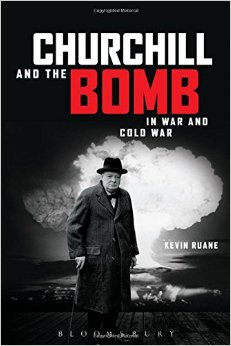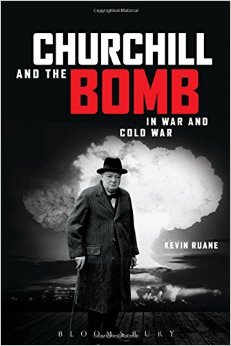
Finest Hour 174
Books, Arts, & Curiosities – Atomic Action

December 30, 2016
Finest Hour 174, Autumn 2016
Page 44
Kevin Ruane, Churchill and the Bomb in War and Cold War, Bloomsbury, 2016, 402 pages, $34.95. ISBN 978–1472523389
Review by Christopher Sterling
Chris Sterling, recently retired after thirty-five years of teaching and administration at George Washington University, is a frequent reviewer for Finest Hour.
 One of those relatively rare academic writers who can make document-based research both readable and interesting (and I say that as a retired academic), Kevin Ruane takes his readers back to the 1940–55 era of rapid atomic and thermonuclear weapon development to illustrate just how dominant fear of the bomb was in policymaking circles. He centers his history on the socalled “special relationship” between the US and Britain, though for much of this period, “special” meant precious little, as the British quickly learned.
One of those relatively rare academic writers who can make document-based research both readable and interesting (and I say that as a retired academic), Kevin Ruane takes his readers back to the 1940–55 era of rapid atomic and thermonuclear weapon development to illustrate just how dominant fear of the bomb was in policymaking circles. He centers his history on the socalled “special relationship” between the US and Britain, though for much of this period, “special” meant precious little, as the British quickly learned.

2024 International Churchill Conference
Following by only three years Graham Farmelo’s well-received Churchill’s Bomb: How the United States Overtook Britain in the First Nuclear Arms Race (Basic Books, 2013) [Reviewed in FH 162], Ruane had a difficult task on his hands. The two British authors take a different approach to their accounts of the same period and people. For one thing, Farmelo is a physicist, while Ruane is an historian. The differences in their studies build on the authors’ academic training by emphasizing different aspects of the complex story. Briefly, Farmelo focuses more on the scientists who did the work while, Ruane centers his study on Churchill himself.
Ruane sees Churchill as playing three related yet quite different roles: the “bomb-maker” during the Second World War; the “atomic diplomatist” during the decade after 1945; and the “nuclear peacemaker” toward the end of his second period as prime minister (1951– 55). His well-written study melds Churchill and key figures close to him—Frederick Lindemann (the “Prof” as the simplifier of complex technologies), Anthony Eden (frustrated by years of waiting for Churchill to retire), Sir John Anderson (chief official of the British “tube alloys” research), Roosevelt (the American president with on-again, off-again views on working with the British in tube alloys), and many others on both sides of the Atlantic.
What many readers may find surprising is that the British were first into the research for a bomb, in crucial theoretical work and some practical efforts. They remained ahead into 1942, when the US began to build (partially on previous British work) what became the huge Manhattan Project. The scope and cost of the work were simply more than war-damaged Britain could afford. But—and this is a central theme in Ruane’s story—as the American effort to build a workable bomb grew, British participation (with a few exceptions) fell by the wayside.
Churchill was appalled that despite two informal atomic bomb cooperative agreements with Roosevelt (one signed at Hyde Park, the other at Quebec), American authorities most directly involved with the bomb project sought (largely successfully) to prevent any sharing of information on bomb fabrication. After the war, Congress formalized American unilateralism with the 1948 McMahon Act, which forbid sharing of atomic secrets with any other nation. Thus British bomb research, moribund since 1942, was reignited, leading to a successful test of a bomb in 1951. But this happened while Churchill was out of power. His chief contribution came after his return to Downing Street when, in 1954, he approved the quest for a British hydrogen bomb, following in the wake of successful H-bomb tests by both America and the Soviet Union. That quest led to Britain becoming the world’s third thermonuclear power.
All of this could be terribly dry in the telling. But Ruane tells it with verve, making good use of personal and other details that provide color. That is vital to retaining a reader’s interest in such a long book. Especially well told is the story of the “July days” in 1954, when Churchill’s government nearly came apart over his solo invitation to Soviet leaders to parlay “at the summit.” The invitation had not been cleared in advance with the Cabinet nor with Washington, the latter a sad indicator of Britain’s diminished world role.
This is an important addition to the Churchill literature, filling a gap (along with Farmelo’s work) in what we can now know—thanks to declassification of documents on both sides of the Atlantic—about a crucial period, especially the postwar jockeying for national position in the growing Cold War.
Subscribe
WANT MORE?
Get the Churchill Bulletin delivered to your inbox once a month.


